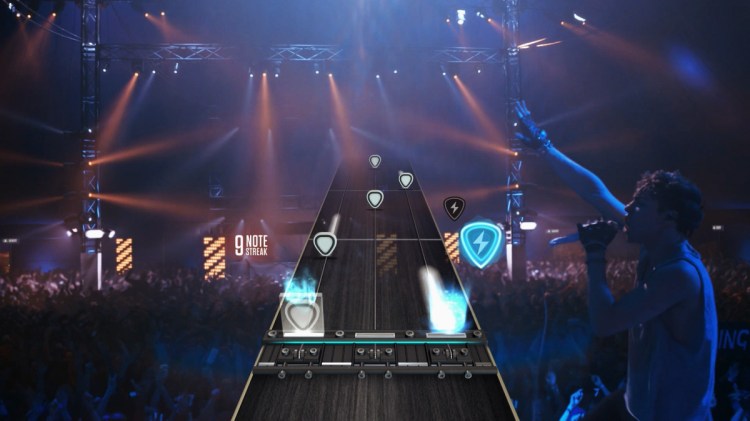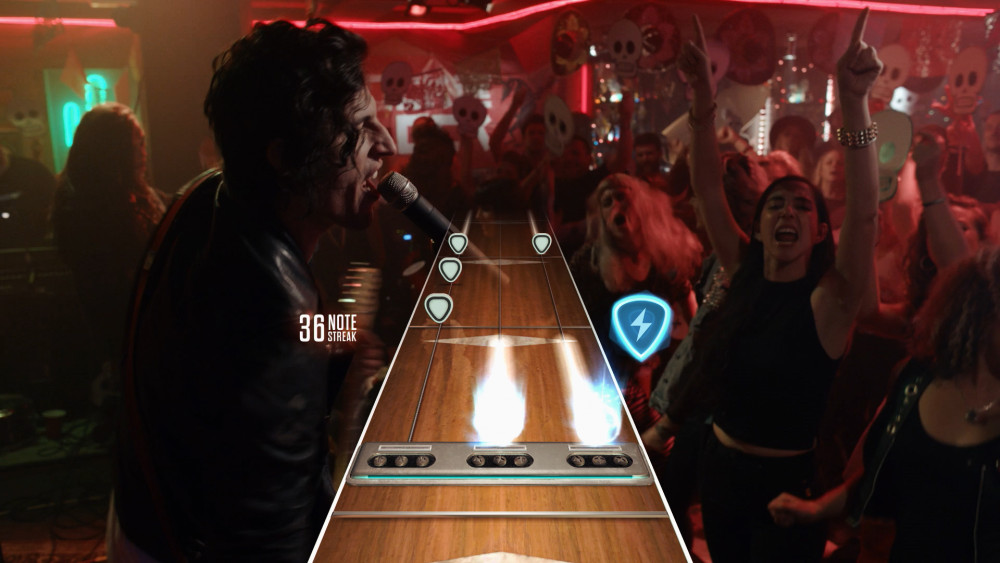What you won’t like
The Live experience is disappointing
I’ve spent most of this review talking about the online side of Guitar Hero Live because the “Live” portion isn’t much to talk about. In this part of the game, 42 songs have been split up into different fake band performances taking place from the perspective of the guitarist. Full-motion video plays in the background instead of 3D models. You’ll hear DJs talk about your performance and hype up your next one in the menus. A different fake band plays each three-song set list, tying everything together in a way that feels more natural than past releases. The interface has also gotten an uplift to match the Live aesthetic, and it makes the entire game feel more mature.
It’s an interesting new approach (and the new look is slick), but you don’t have much reason to replay the set lists or play songs individually unless you’re going for high scores. The online side is much more enticing and includes all of the on-disc tracks in the rotation. The Live part of Guitar Hero Live is worth seeing once, but it seems like the least important part of the package. It feels like a backup mode in case the servers go offline.
The vocals are marginalized
Guitar Hero Live also lets you sing vocals, but you wouldn’t know it at first. You can only try vocals in tandem with the guitar, so you’ll either have to do both, have someone else join in, or just completely disregard the guitar note track and sing instead. Vocals feel like an afterthought, but I appreciate them being there, I suppose. You can also get a companion app that lets you use your phone as a microphone. But, I found the detection of vocals across all the mics I’ve tried (including my phone) a bit spotty.
Don’t plan a Guitar Hero party
With two guitars and vocals, Guitar Hero Live lets you play with a maximum of three people. But if I’m ever going to plan a party centered on a rhythm game, Rock Band is still my choice. Guitar Hero Live doesn’t let you play with as many people, and despite being able to have two guitars, you can’t play bass parts. It’s not a huge loss, but I definitely felt the absence of bass sequences during Jack White’s “Lazaretto.” This simply isn’t a group experience. I consider the second guitar a backup since the one I’ve been using thus far has started to squeak.
Conclusion
Although Rock Band still has the bigger catalog, more instruments, and backward compatibility, Guitar Hero Live is progressive, nimble, and, well, lively. The new guitar and GHTV system get me truly excited about playing rhythm titles again. After seeing what Freestyle Games has done, Rock Band’s enormous library, and the promise of making it available across releases feels like a crutch by comparison, tying that franchise to its established model. I’ll still hop back to Rock Band to play drums, but right now, Guitar Hero Live is where you’ll find me clanking away, waiting for the next time I get to perform Ida Maria’s “I Like You So Much Better When You’re Naked.”
Score: 87/100
Guitar Hero Live is out now for Xbox One, Playstation 4, Xbox 360, Playstation 3, and iOS. The publisher provided GamesBeat with a copy of the Xbox One Guitar 2-Pack Bundle and two microphones for this review.
VentureBeat's mission is to be a digital town square for technical decision-makers to gain knowledge about transformative enterprise technology and transact. Learn More



